Torsional Crack Localization in Palm Oil Clinker Concrete Using Acoustic Emission Method
Abstract
1. Introduction
2. Experimental Works
2.1. Materials and Mix Design
2.2. Specimen Preparation and Test Setup
3. Results and Discussion
3.1. Mechanical Properties
3.2. Torsional Behavior
3.3. Acoustic Emission Method for Crack Detection
3.3.1. Absolute Energy
3.3.2. Cumulative Signal Strength (CSS)
3.4. Cracks
3.4.1. Comparison between POC 0% and POC 100%
3.4.2. Comparison between the Mixes
4. Conclusions
- Maximum reductions of 18.83, 37.25, 30.94, and 14.31% in hard density, compression strength, splitting tensile strength, and flexural strength of concrete, respectively, occurred when POC was fully substituted for granite in the concrete mix. Meanwhile, the water absorption of the POC100 specimens was 1.78 times higher than that of POC0 specimens.
- The initial and ultimate torque decreased by increasing the amount of POC and showed a reciprocal relationship with the initial and ultimate cracks. POC40 specimens had the maximum initial torque among all POCC specimens. In addition, POC40 specimens had high initial torsional stiffness but had the lowest angle of twist when compared with all specimens.
- POC100 specimens sustained the initial and ultimate torque at a large angle of twist and was comparable to the control (POC0) specimens. However, the initial torsional stiffness and ultimate torsional toughness of POC100 were 1.64 and 2 times smaller than the control (POC0) specimens, respectively.
- The absolute energy was found to be a useful AE parameter for the detection of both initial and ultimate torsional cracks. On the other hand, the AE amplitude and CSS parameter were found to be capable of identifying the growth of cracks and the ultimate torsional cracks. High-intensity AE events were recorded, and high-energy dissipations were observed for POC0 and POC100 specimens. The initial crack for the tested specimens occurred almost in the range of 14–25% of the ultimate crack.
- The failure pattern of all tested specimens had a skewed bending failure. In addition, the width of the crack increased with the increase in the replacement ratio of granite with POC. POC80 and POC100 specimens broke into two and three pieces, respectively.
5. Recommendations
Author Contributions
Funding
Institutional Review Board Statement
Informed Consent Statement
Data Availability Statement
Acknowledgments
Conflicts of Interest
References
- Aslam, M.; Shafigh, P.; Jumaat, M.Z. Oil-palm by-products as lightweight aggregate in concrete mixture: A review. J. Clean Prod. 2016, 126, 56–73. [Google Scholar] [CrossRef]
- Ibrahim, H.A.; Razak, H.A. Effect of palm oil clinker incorporation on properties of pervious concrete. Constr. Build. Mater. 2016, 115, 70–77. [Google Scholar] [CrossRef]
- Mohammed, B.S.; Foo, W.L.; Hossain, K.M.A.; Abdullahi, M. Shear strength of palm oil clinker concrete beams. Mater. Des. 2013, 46, 270–276. [Google Scholar] [CrossRef]
- Gayana, B.; Chandar, K.R. Sustainable use of mine waste and tailings with suitable admixture as aggregates in concrete pavements-A review. Adv. Concr. Constr. 2018, 6, 221–243. [Google Scholar]
- Thomas, J.; Thaickavil, N.N.; Abraham, M.P. Copper or ferrous slag as substitutes for fine aggregates in concrete. Adv. Concr. Constr. 2018, 6, 545–560. [Google Scholar]
- Abutaha, F.; Razak, H.A.; Ibrahim, H.A.; Ghayeb, H.H. Adopting particle-packing method to develop high strength palm oil clinker concrete. Resour. Conser. Recycl. 2018, 131, 247–258. [Google Scholar] [CrossRef]
- Ahmmad, R.; Jumaat, M.Z.; Alengaram, U.J.; Bahri, S.; Rehman, M.A.; Hashim, H.B. Performance evaluation of palm oil clinker as coarse aggregate in high strength lightweight concrete. J. Clean Prod. 2016, 112, 566–574. [Google Scholar] [CrossRef]
- Abutaha, F.; Razak, H.A.; Kanadasan, J. Effect of palm oil clinker (POC) aggregates on fresh and hardened properties of concrete. Constr. Build. Mater. 2016, 112, 416–423. [Google Scholar] [CrossRef]
- Mannan, M.; Ganapathy, C. Concrete from an agricultural waste-oil palm shell (OPS). Build. Environ. 2004, 39, 441–448. [Google Scholar] [CrossRef]
- Shafigh, P.; Mahmud, H.B.; Jumaat, M.Z. Oil palm shell lightweight concrete as a ductile material. Mater. Des (1980–2015). 2012, 360, 650–654. [Google Scholar] [CrossRef]
- Sharath, S.; Gayana, B.C.; Reddy, K.R.; Chandar, K.R. Experimental investigations on performance of concrete incorporating Precious Slag Balls (PS Balls) as fine aggregates. Adv. Concr. Constr. 2019, 8, 239–246. [Google Scholar]
- Suman, S.; Rajasekaran, C. Mechanical properties of recycled aggregate concrete produced with Portland Pozzolana Cement. Adv. Concr. Constr. 2016, 4, 27–35. [Google Scholar] [CrossRef]
- Kanadasan, J.; Fauzi, A.F.A.; Razak, H.A.; Selliah, P.; Subramaniam, V.; Yusoff, S. Feasibility Studies of Palm Oil Mill Waste Aggregates for the Construction Industry. Materials 2015, 8, 6508–6530. [Google Scholar] [CrossRef]
- Ibrahim, H.A.; Razak, H.A.; Abutaha, F. Strength and abrasion resistance of palm oil clinker pervious concrete under different curing method. Constr. Build. Mater. 2017, 147, 576–587. [Google Scholar] [CrossRef]
- Kanadasan, J.; Razak, H.A. Utilization of Palm Oil Clinker as Cement Replacement Material. Materials 2015, 8, 8817–8838. [Google Scholar] [CrossRef] [PubMed]
- Alsubari, B.; Shafigh, P.; Ibrahim, Z.; Alnahhal, M.F.; Jumaat, M.Z. Properties of eco-friendly self-compacting concrete containing modified treated palm oil fuel ash. Constr. Build. Mater. 2018, 158, 742–754. [Google Scholar] [CrossRef]
- Jumaat, M.Z.; Alengaram, U.J.; Ahmmad, R.; Bahri, S.; Islam, A.B.M.S. Characteristics of palm oil clinker as replacement for oil palm shell in lightweight concrete subjected to elevated temperature. Constr. Build. Mater. 2015, 101, 942–951. [Google Scholar] [CrossRef]
- Kanadasan, J.; Razak, H.A. Engineering and sustainability performance of self-compacting palm oil mill incinerated waste concrete. J. Clean Prod. 2015, 89, 78–86. [Google Scholar] [CrossRef]
- Ahmmad, R.; Alengaram, U.J.; Jumaat, M.Z.; Sulong, N.H.R.; Yusuf, M.O.; Rehman, M.A. Feasibility study on the use of high volume palm oil clinker waste in environmental friendly lightweight concrete. Constr. Build. Mater. 2017, 135, 94–103. [Google Scholar] [CrossRef]
- Abutaha, F.; Abdul Razak, H.; Ibrahim, H.A. Effect of coating palm oil clinker aggregate on the engineering properties of normal grade concrete. Coatings 2017, 7, 175. [Google Scholar] [CrossRef]
- Karim, M.R.; Chowdhury, F.I.; Zabed, H.; Saidur, M.R. Effect of elevated temperatures on compressive strength and microstructure of cement paste containing palm oil clinker powder. Constr. Build. Mater. 2018, 183, 376–383. [Google Scholar] [CrossRef]
- Huda, M.N.; Jumaat, M.Z.; Islam, A.B.M.S.; Darain, K.M.U.; Obaydullah, M.; Hosen, M.A. Palm oil industry’s bi-products as coarse aggregate in structural lightweight concrete. Comput. Concr. 2017, 19, 515–526. [Google Scholar] [CrossRef]
- Yap, S.P.; Khaw, K.R.; Alengaram, U.J.; Jumaat, M.Z. Effect of fibre aspect ratio on the torsional behaviour of steel fibre-reinforced normal weight concrete and lightweight concrete. Eng. Struct. 2015, 101, 24–33. [Google Scholar] [CrossRef]
- Yap, S.P.; Alengaram, U.J.; Jumaat, M.Z.; Khaw, K.R. Torsional and cracking characteristics of steel fiber-reinforced oil palm shell lightweight concrete. J. Compos. Mater. 2016, 50, 115–128. [Google Scholar] [CrossRef]
- George, A.; Sofi, A. Torsional and cracking behaviours of normal weight and coconut shell lightweight concretes. J. Eng. Sci. Technol. 2018, 13, 4104–4117. [Google Scholar]
- George, A.; Sofi, A. Torsional strengthening of normal weight concrete and light weight concrete using steel fibres. Mater. Today Proc. 2017, 4, 9846–9850. [Google Scholar] [CrossRef]
- Qian, Y.; Farnam, Y.; Weiss, J. Using acoustic emission to quantify freeze–thaw damage of mortar saturated with NaCl solutions. In Proceedings of the 4th International Conference on the Durability of Concrete Structures, West Lafayette, IN, USA, 24–26 July 2014. [Google Scholar]
- Zaki, A.; Chai, H.K.; Aggelis, D.G.; Alver, N. Non-destructive evaluation for corrosion monitoring in concrete: A review and capability of acoustic emission technique. Sensors 2015, 15, 19069–19101. [Google Scholar] [CrossRef]
- Landis, E.N.; Baillon, L. Experiments to relate acoustic emission energy to fracture energy of concrete. J. Eng. Mech. 2002, 128, 698–702. [Google Scholar] [CrossRef]
- Sherif, M.M.; Khakimova, E.M.; Tanks, J.; Ozbulut, O.E. Cyclic flexural behavior of hybrid SMA/steel fiber reinforced concrete analyzed by optical and acoustic techniques. Compos. Struct. 2018, 201, 248–260. [Google Scholar] [CrossRef]
- Sherif, M.M.; Tanks, J.; Ozbulut, O.E. Acoustic emission analysis of cyclically loaded superelastic shape memory alloy fiber reinforced mortar beams. Cem. Concr. Res. 2017, 95, 178–187. [Google Scholar] [CrossRef]
- Jiang, Z.; Sherif, M.M.; Xing, G.; Ozbulut, O.E. Tensile characterization of graphene nanoplatelets (GNP) mortar using acoustic emissions. Mater. Today Commun. 2020, 25, 101433. [Google Scholar] [CrossRef]
- Mazal, P.; Vlasic, F.; Koula, V. Use of acoustic emission method for identification of fatigue micro-cracks creation. Proc. Eng. 2015, 133, 379–388. [Google Scholar] [CrossRef]
- MS 522: PART 1:2003. Portland Cement (Ordinary and Rapid-Hardening); MS Standards Publication: Cyberjaya, Malaysia, 2003.
- ASTM C127—15. Standard Test Method for Relative Density (Specific Gravity) and Absorption of Coarse Aggregate; ASTM International: West Conshohocken, PA, USA, 2015.
- BS EN 1097-3:1998. Tests for Mechanical and Physical Properties of Aggregates. Determination of Loose Bulk Density and Voids; British Standards Institution: London, UK, 1998.
- BS EN 1097-2:1998. Testing Aggregates. Method for Determination of Aggregate Impact Value (AIV); British Standards Institution: London, UK, 1998.
- BS EN 12390-3:2019. Testing Hardened Concrete. Compressive Strength of Test Specimens; British Standards Institution: London, UK, 2019.
- BS 1881-122. Testing Concrete Part 122. Method for Determination of Water Absorption; British Standards Institution: London, UK, 2016.
- BS EN 12504-4:2004. Testing Concrete. Determination of Ultrasonic Pulse Velocity; British Standards Institution: London, UK, 2004.
- BS EN 12390-6:2009. Testing Hardened Concrete. Tensile Splitting Strength of Test Specimens; British Standards Institution: London, UK, 2010.
- BS EN 12390-5:2019. Testing Hardened Concrete. Flexural Strength of Test Specimens; British Standards Institution: London, UK, 2019.
- Okay, F.; Engin, S. Torsional behavior of steel fiber reinforced concrete beams. Constr. Build. Mater. 2012, 28, 269–275. [Google Scholar] [CrossRef]
- Hamada, H.M.; Jokhio, G.A.; Al-Attar, A.A.; Yahaya, F.M.; Muthusamy, K.; Humada, A.M.; Gul, Y. The use of palm oil clinker as a sustainable construction material: A review. Cem. Concr. Compos. 2019, 106, 103447. [Google Scholar] [CrossRef]
- Mohammed, B.S.; Foo, W.; Abdullahi, M. Flexural strength of palm oil clinker concrete beams. Mater. Des. 2014, 53, 325–331. [Google Scholar] [CrossRef]
- Lo, T.Y.; Cui, H.Z.; Tang, W.C.; Leung, W.M. The effect of aggregate absorption on pore area at interfacial zone of lightweight concrete. Constr. Build. Mater. 2008, 22, 623–628. [Google Scholar] [CrossRef]
- Hamada, H.M.; Yahaya, F.M.; Muthusamy, K.; Jokhio, G.A.; Humada, A.M. Fresh and hardened properties of palm oil clinker lightweight aggregate concrete incorporating nano-palm oil fuel ash. Constr. Build. Mater. 2019, 214, 344–354. [Google Scholar] [CrossRef]
- Ahmad, H.; Hilton, M.; Mohd, S.; Mohd Noor, N. Mechanical properties of palm oil clinker concrete. In Proceedings of the 1st Engineering Conference: Energy and Environment, Kuching, Sarawak, Malaysia, 27–28 December 2007. [Google Scholar]
- Aslam, M.; Shafigh, P.; Nomeli, M.A.; Jumaat, M.Z. Manufacturing of high-strength lightweight aggregate concrete using blended coarse lightweight aggregates. J. Build. Eng. 2017, 13, 53–62. [Google Scholar] [CrossRef]
- Ing, M.; Austin, S.; Lyons, R. Cover zone properties influencing acoustic emission due to corrosion. Cem. Concr. Res. 2005, 35, 284–295. [Google Scholar] [CrossRef]
- Shahidan, S.; Abdullah, S.R.; Ismail, I. Relationship between AE signal strength and absolute energy in determining damage classification of concrete structures. J. Teknol. 2016, 78, 91–98. [Google Scholar] [CrossRef][Green Version]
- Shahidan, S.; Md Nor, N.; Ibrahim, A.; Muhamad Bunnori, N.; Saliah, M.; Noor, S. Relationship between acoustic emission signal strength and damage evaluation of reinforced concrete structure: Case Studies. In Proceedings of the 2011 IEEE Symposium on Industrial Electronics and Applications, Langkawi, Malaysia, 25–28 September 2011. [Google Scholar]
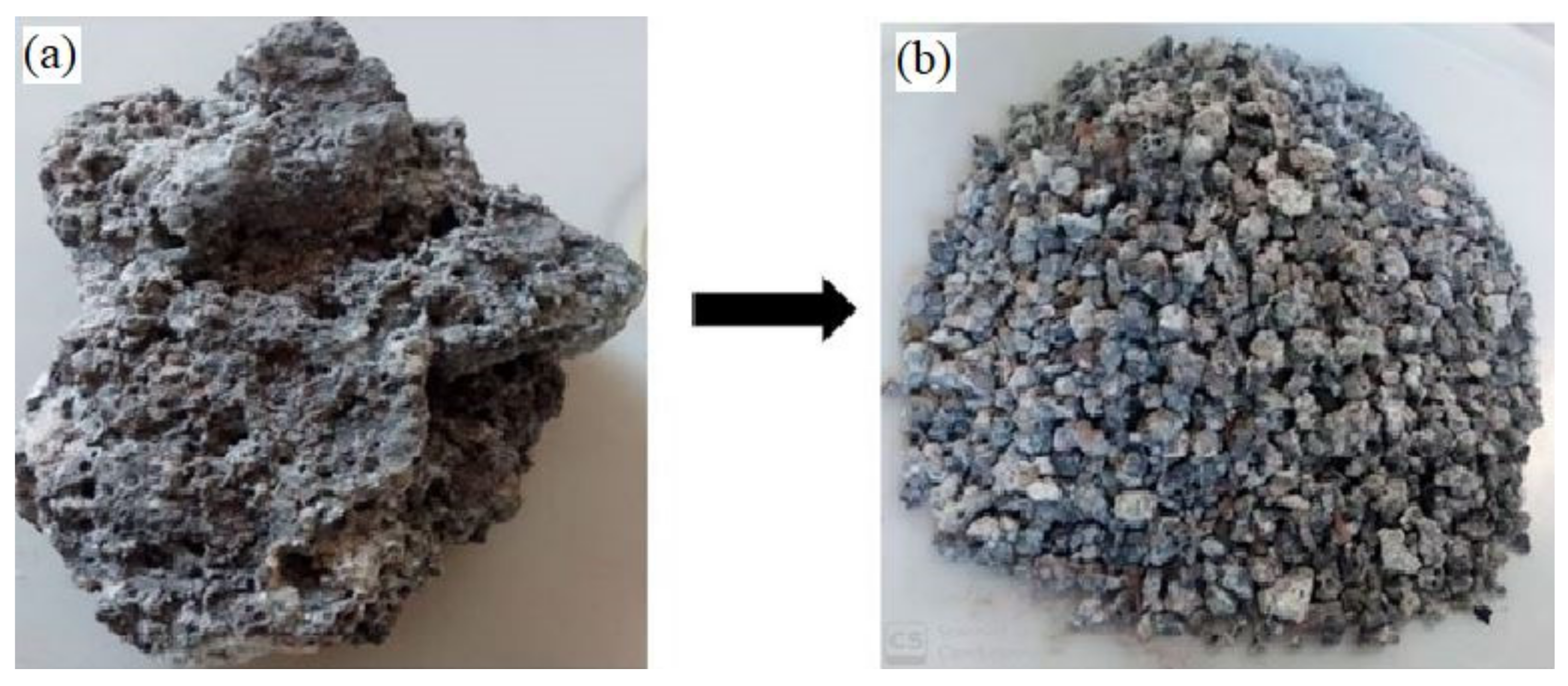
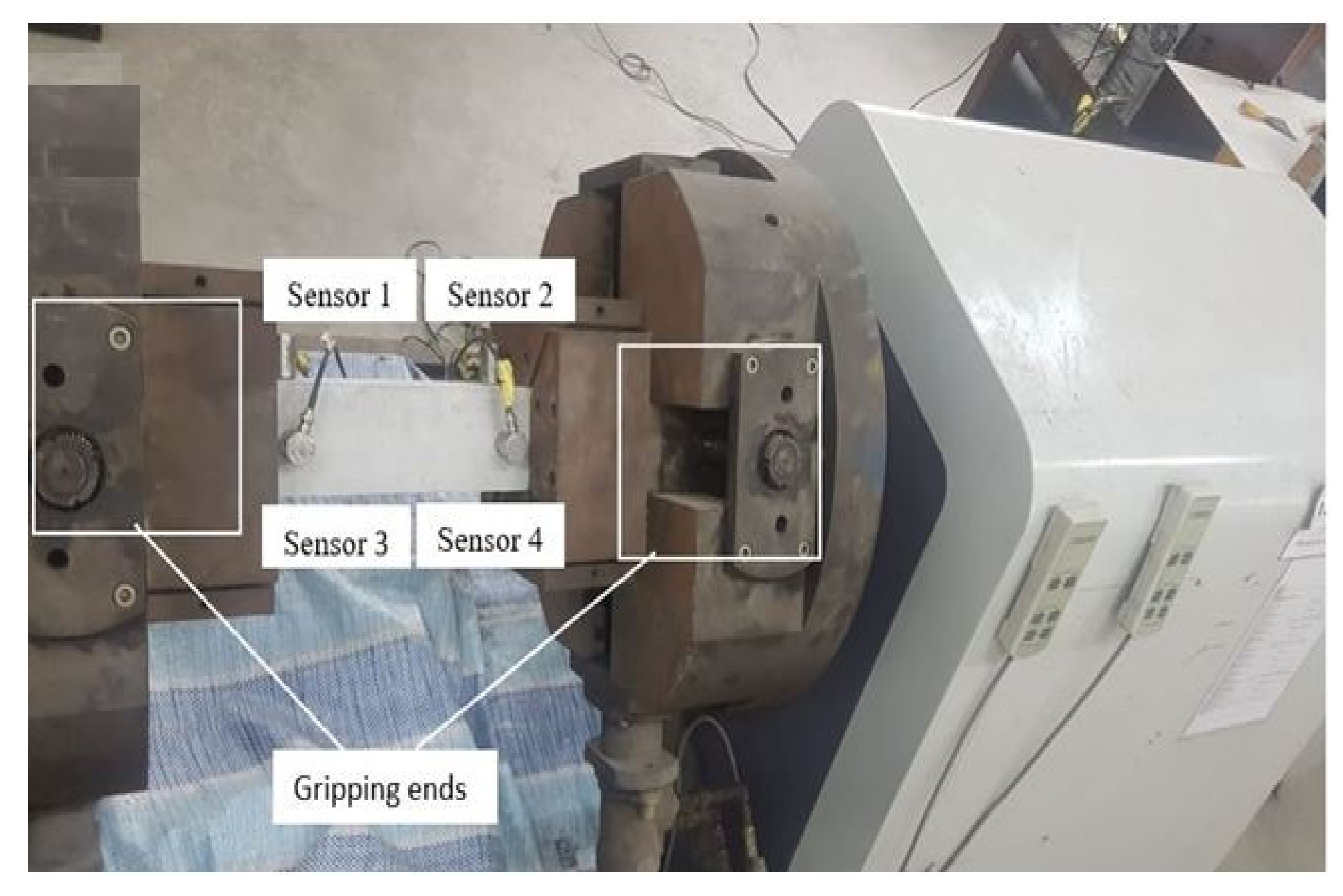
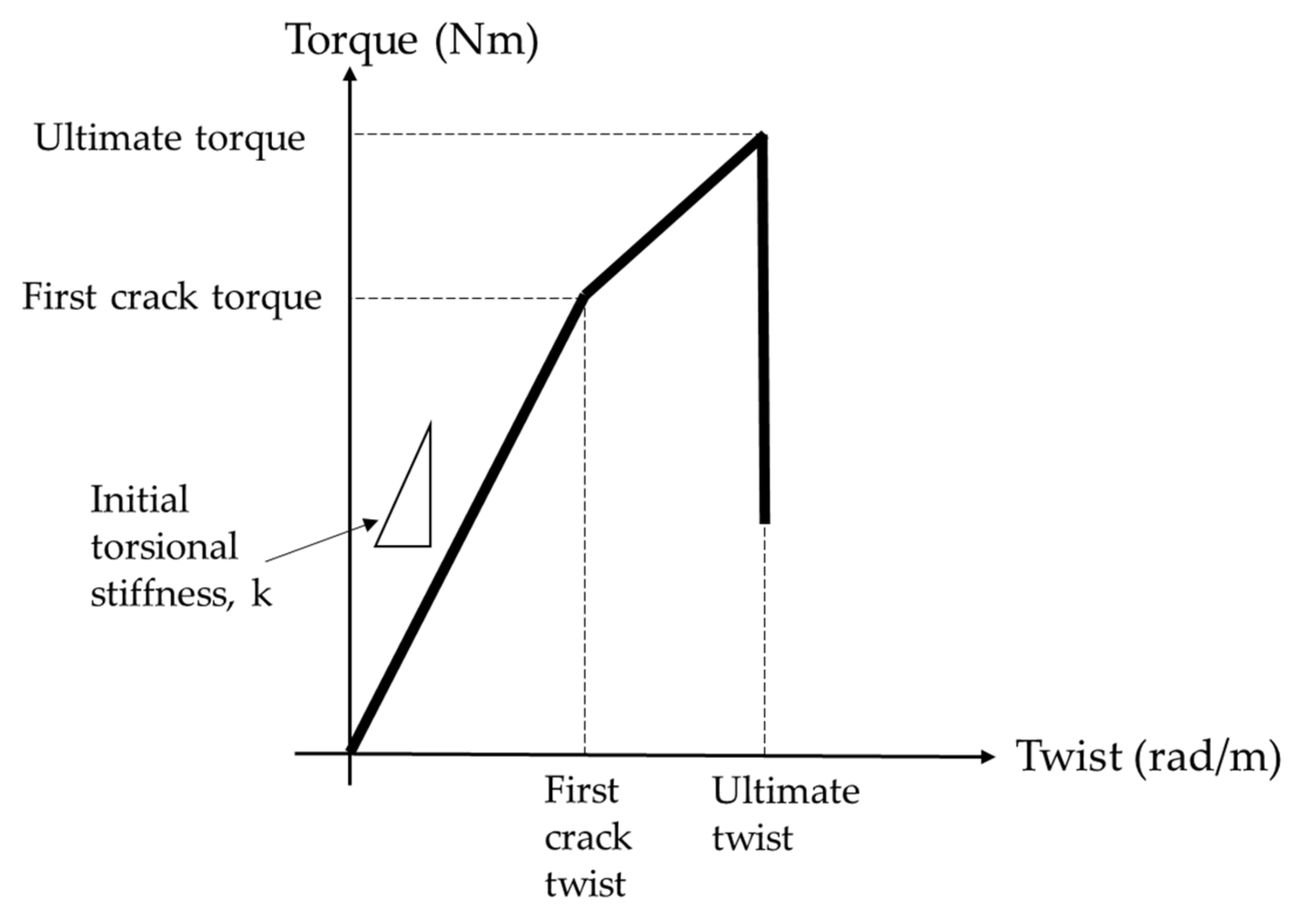
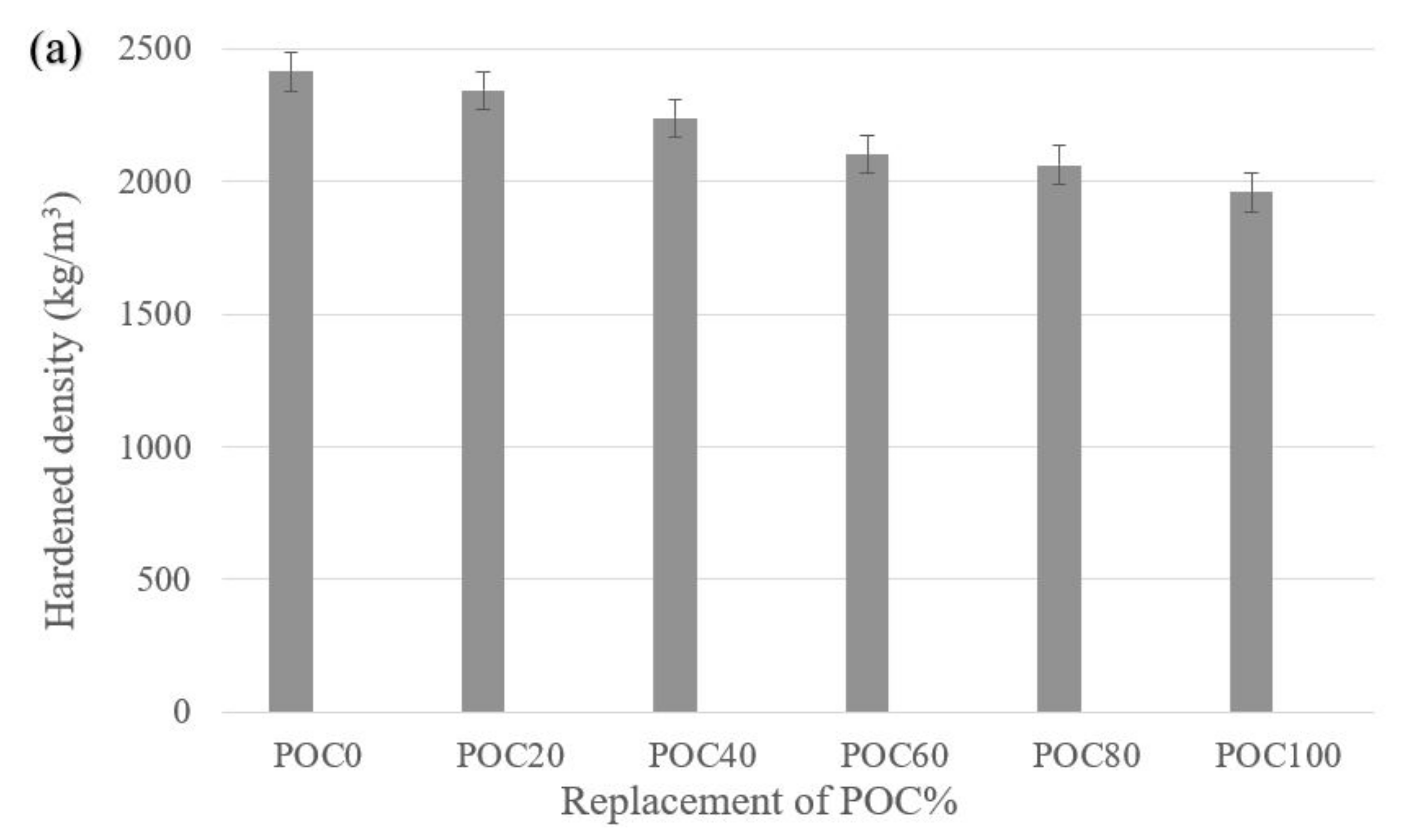
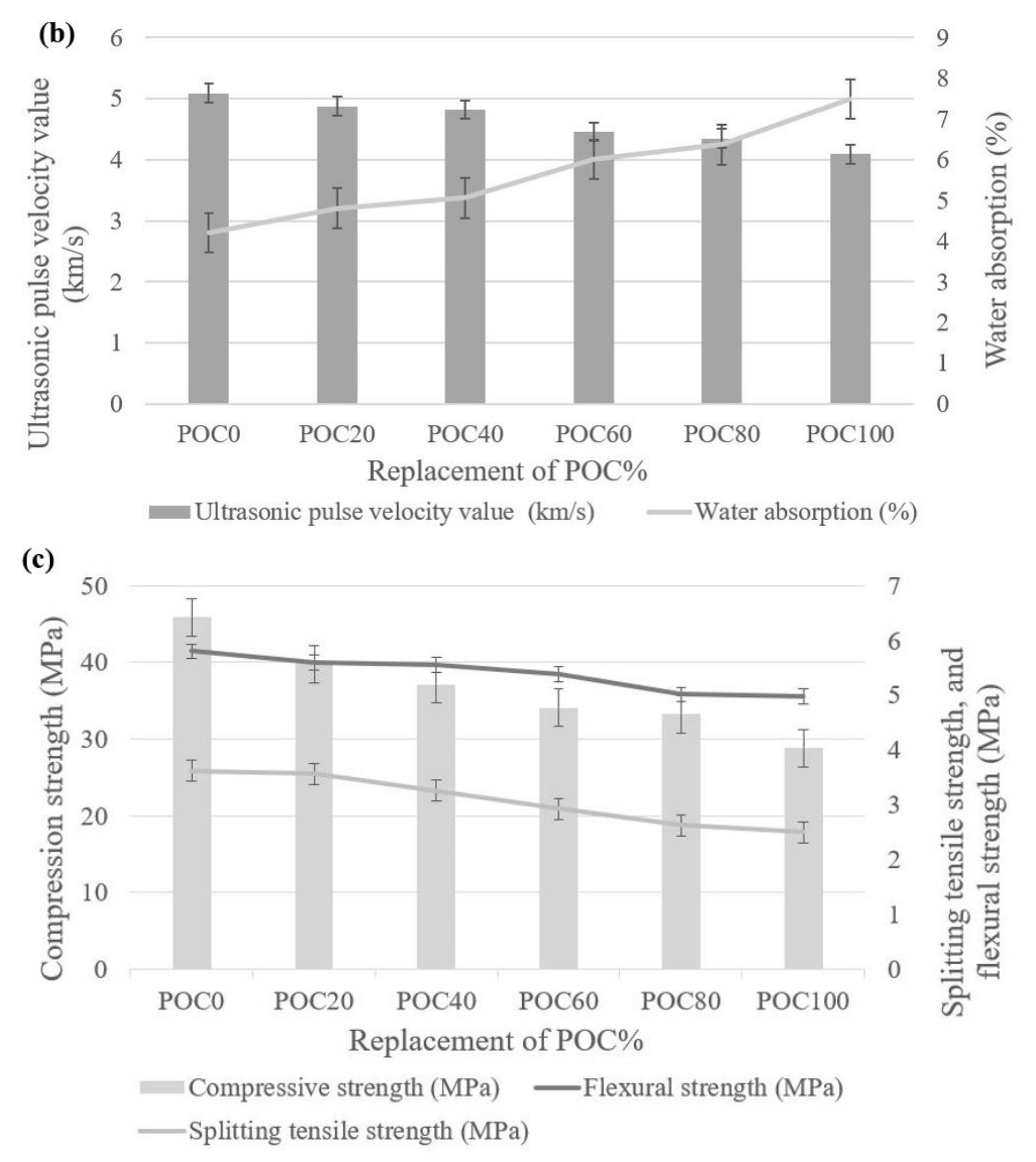
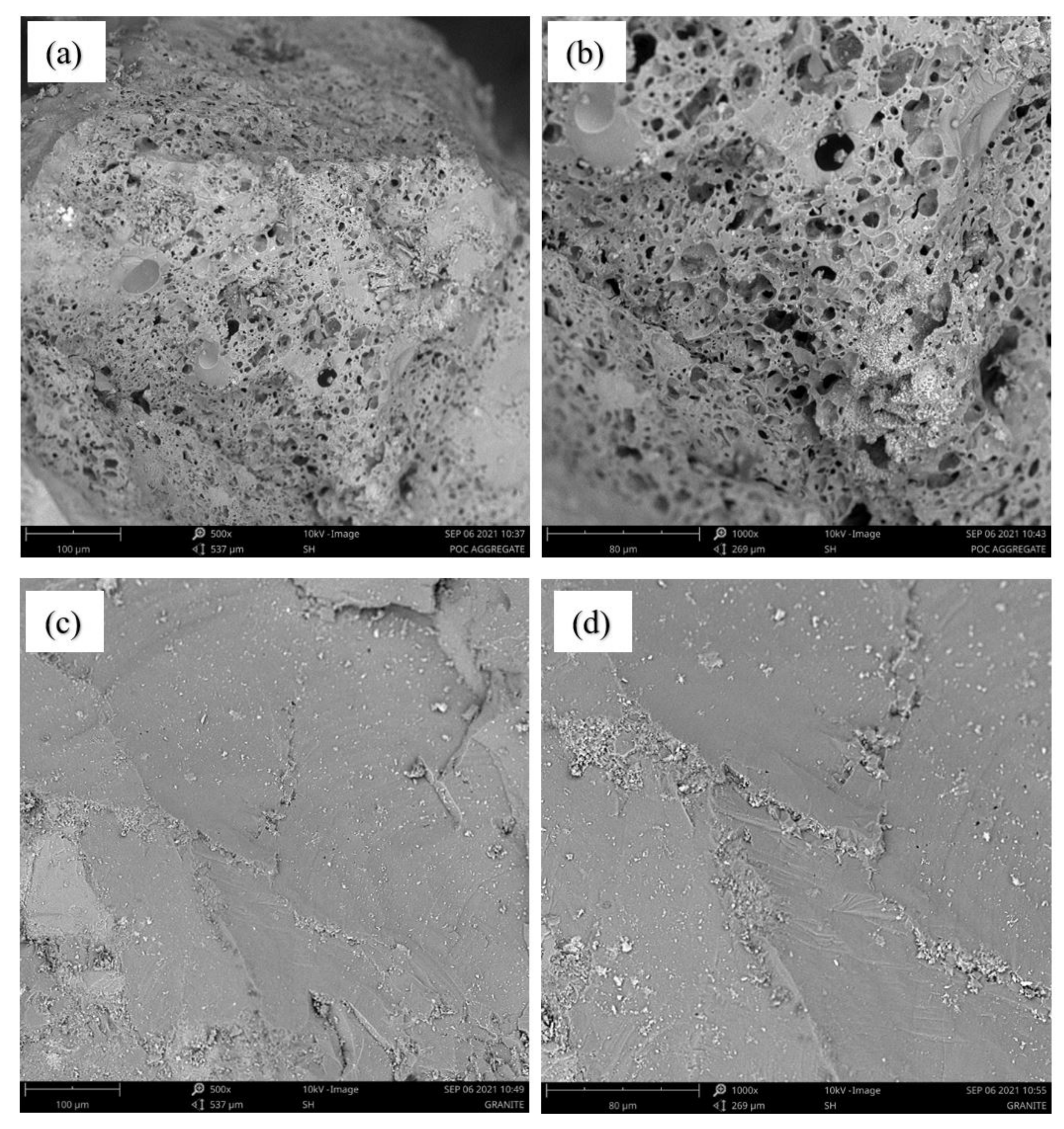


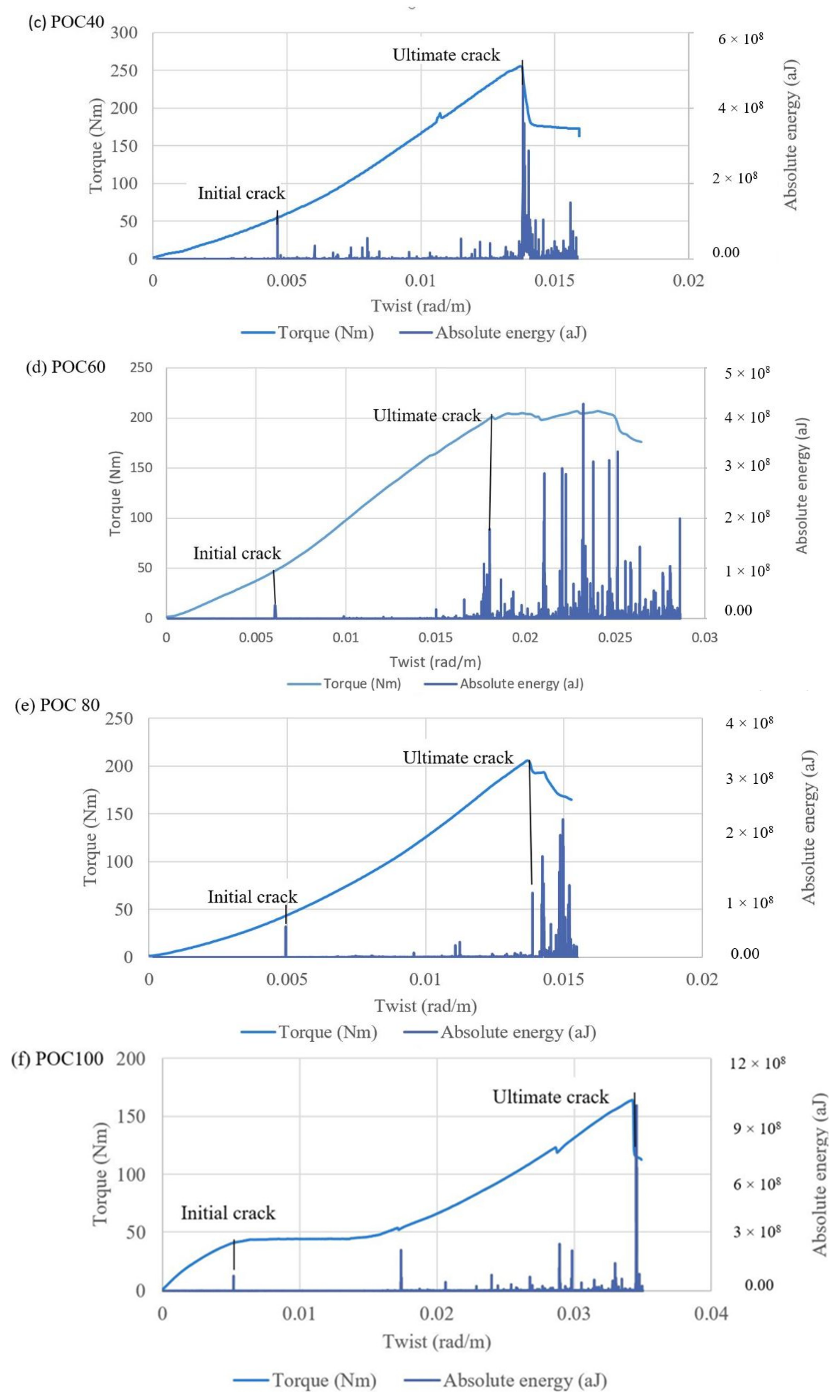
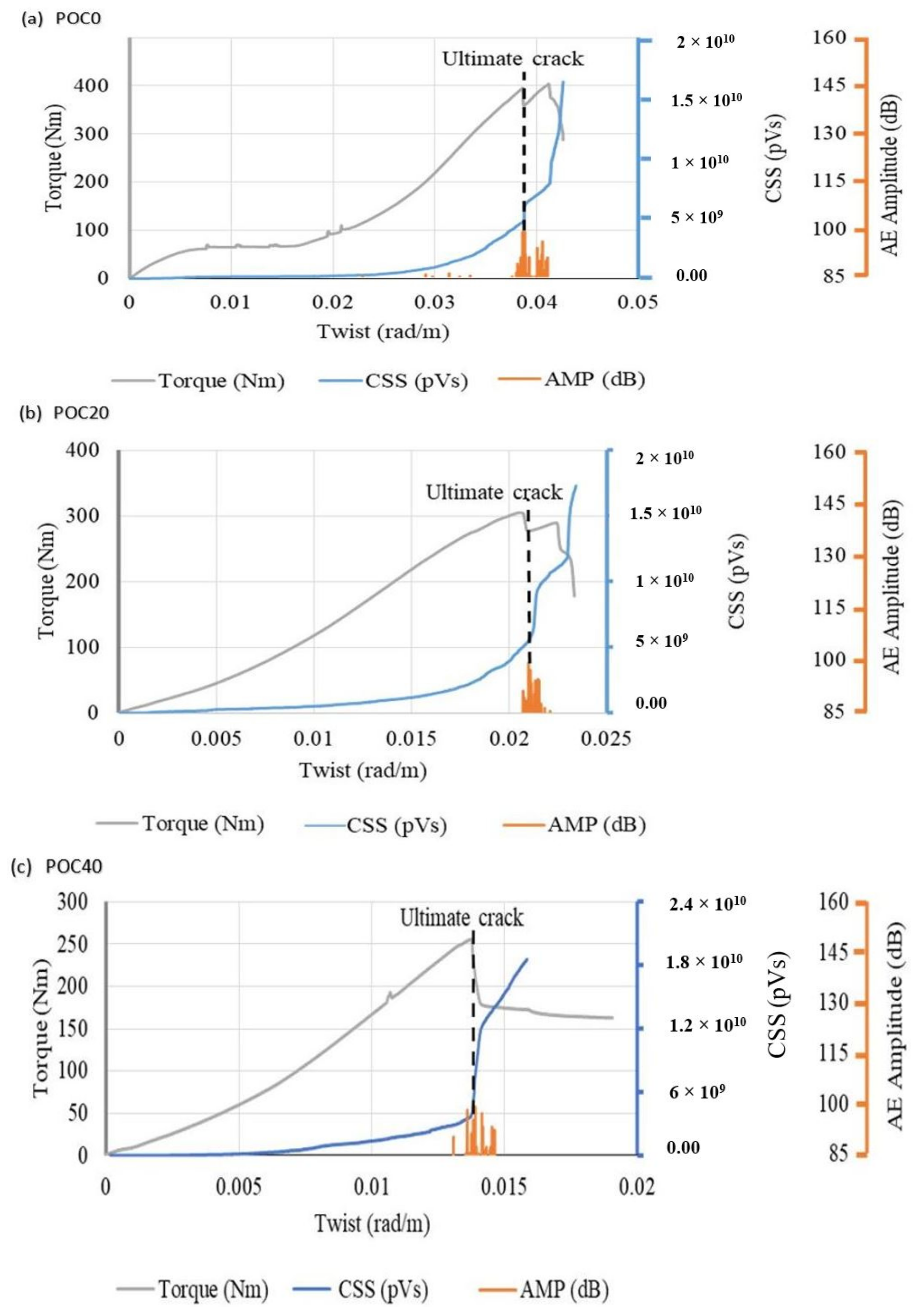
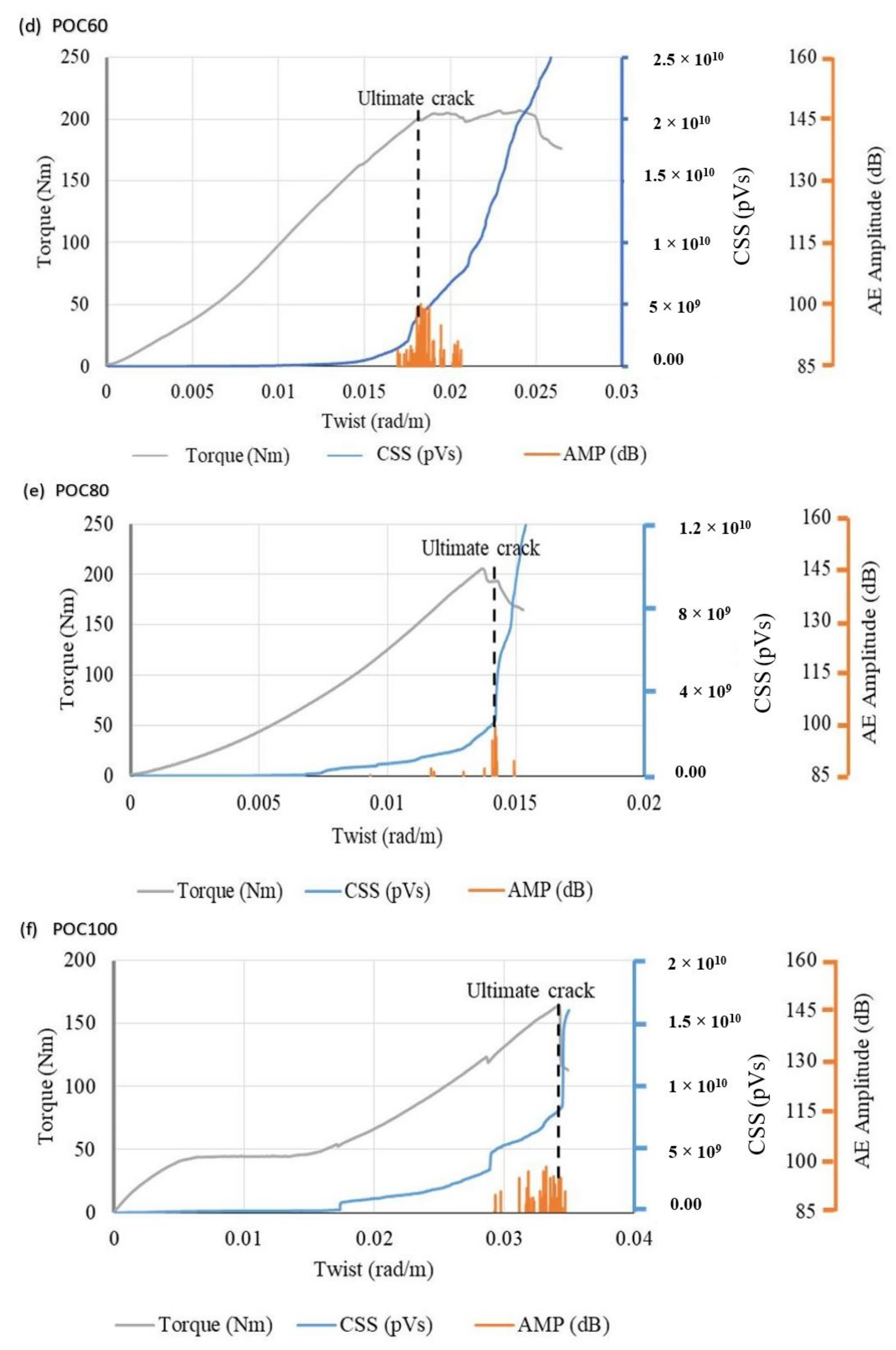


| Properties | Aggregates | ||
|---|---|---|---|
| River Sand | Coarse Aggregates | ||
| Granite | POC | ||
| Aggregate size (mm) | <4.75 | 4.75–20 | 4.75–14 |
| Specific gravity (SSD) | 2.5 | 2.6 | 1.54 |
| Specific gravity (oven dry) | 2.4 | 2.59 | 1.4 |
| Specific gravity(apparent) | 2.64 | 2.62 | 1.61 |
| Water absorption (%) | 4.12 | 0.4 | 9.4 |
| Aggregate impact value (%) | - | 20.5 | 47.9 |
| Bulk density (loose condition), kg/m3 | 1571.5 | 1431.7 | 599.9 |
| Bulk density (compacted condition), kg/m3 | 1706.9 | 1572.1 | 694.4 |
| Replacement Level (%) | Batch | Water Cement Ratio | Mix Proportion (kg/m3) | ||||
|---|---|---|---|---|---|---|---|
| Water | Ordinary Portland Cement OPC | River Sand | Granite | POC Coarse Aggregate | |||
| 0 | POC0 | 0.53 | 205 | 410 | 830 | 935 | 0 |
| 20 | POC20 | 0.53 | 205 | 410 | 830 | 748 | 110.76 |
| 40 | POC40 | 0.53 | 205 | 410 | 830 | 561 | 221.52 |
| 60 | POC60 | 0.53 | 205 | 410 | 830 | 374 | 332.29 |
| 80 | POC80 | 0.53 | 205 | 410 | 830 | 187 | 443.05 |
| 100 | POC100 | 0.53 | 205 | 410 | 830 | 0 | 553.81 |
| Mix ID | Cracking Torque | Ultimate Torque | Initial Stiffness (kNm2) | Initial Toughness (Nm/m) | Ultimate Toughness (Nm/m) | ||
|---|---|---|---|---|---|---|---|
| Torque (Nm) | Twist (rad/m) | Torque (Nm) | Twist (rad/m) | ||||
| POC0 | 57.46 | 0.0056 | 397.24 | 0.039 | 12.47 | 0.16 | 5.37 |
| POC20 | 51.62 | 0.0055 | 305.09 | 0.020 | 9.02 | 0.15 | 2.84 |
| POC40 | 54.77 | 0.0046 | 255.65 | 0.017 | 11.47 | 0.13 | 1.48 |
| POC60 | 47.18 | 0.0060 | 201.20 | 0.018 | 7.81 | 0.13 | 1.64 |
| POC80 | 42.61 | 0.0049 | 205.89 | 0.014 | 8.59 | 0.11 | 1.14 |
| POC100 | 41.13 | 0.0052 | 164.37 | 0.034 | 7.61 | 0.11 | 2.48 |
| Mix ID | Initial Crack | Ultimate Crack | ||||
|---|---|---|---|---|---|---|
| Absolute Energy (aJ) | Cumulative Signal Strength (pVs) | Cracking Twist (rad/m) | Absolute Energy (aJ) | CSS (pVs) | Ultimate Twist (rad/m) | |
| POC0 | 3.63 × 107 | 1.03 × 108 | 0.0056 | 7.11 × 108 | 5.44 × 109 | 0.039 |
| POC20 | 1.48 × 107 | 2.79 × 108 | 0.0055 | 2.12 × 108 | 4.71 × 109 | 0.020 |
| POC40 | 1.12 × 108 | 1.13 × 108 | 0.0046 | 4.80 × 108 | 4.69 × 109 | 0.017 |
| POC60 | 2.71 × 107 | 1.47 × 107 | 0.0060 | 1.79 × 108 | 3.90 × 109 | 0.018 |
| POC80 | 5.12 × 107 | 1.74 × 107 | 0.0049 | 1.08 × 108 | 2.26 × 109 | 0.014 |
| POC100 | 7.71 × 107 | 8.27 × 107 | 0.0052 | 9.49 × 108 | 1.26 × 1010 | 0.034 |
Publisher’s Note: MDPI stays neutral with regard to jurisdictional claims in published maps and institutional affiliations. |
© 2021 by the authors. Licensee MDPI, Basel, Switzerland. This article is an open access article distributed under the terms and conditions of the Creative Commons Attribution (CC BY) license (https://creativecommons.org/licenses/by/4.0/).
Share and Cite
Khan, S.; Yap, S.P.; Tan, C.G.; Ganasan, R.; Sherif, M.M.; El-Shafie, A. Torsional Crack Localization in Palm Oil Clinker Concrete Using Acoustic Emission Method. Materials 2021, 14, 5446. https://doi.org/10.3390/ma14185446
Khan S, Yap SP, Tan CG, Ganasan R, Sherif MM, El-Shafie A. Torsional Crack Localization in Palm Oil Clinker Concrete Using Acoustic Emission Method. Materials. 2021; 14(18):5446. https://doi.org/10.3390/ma14185446
Chicago/Turabian StyleKhan, Safdar, Soon Poh Yap, Chee Ghuan Tan, Reventheran Ganasan, Muhammad M. Sherif, and Ahmed El-Shafie. 2021. "Torsional Crack Localization in Palm Oil Clinker Concrete Using Acoustic Emission Method" Materials 14, no. 18: 5446. https://doi.org/10.3390/ma14185446
APA StyleKhan, S., Yap, S. P., Tan, C. G., Ganasan, R., Sherif, M. M., & El-Shafie, A. (2021). Torsional Crack Localization in Palm Oil Clinker Concrete Using Acoustic Emission Method. Materials, 14(18), 5446. https://doi.org/10.3390/ma14185446







